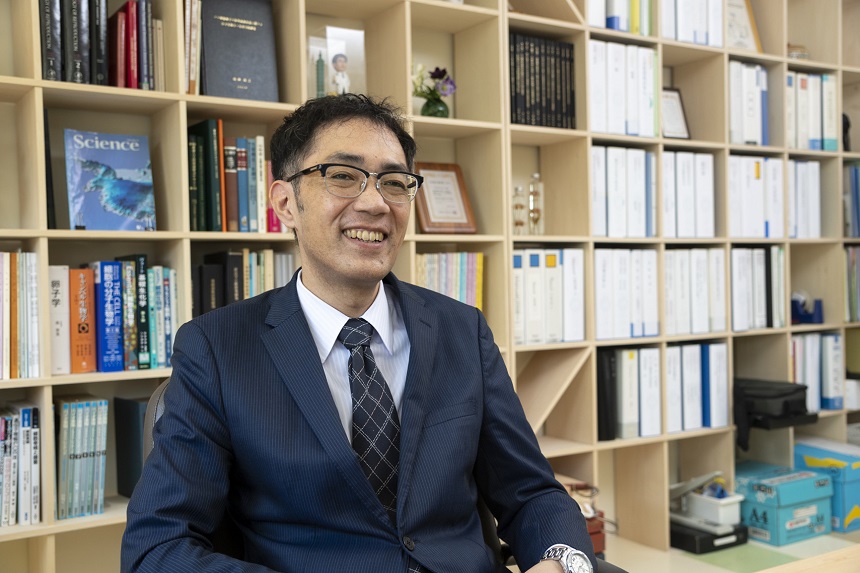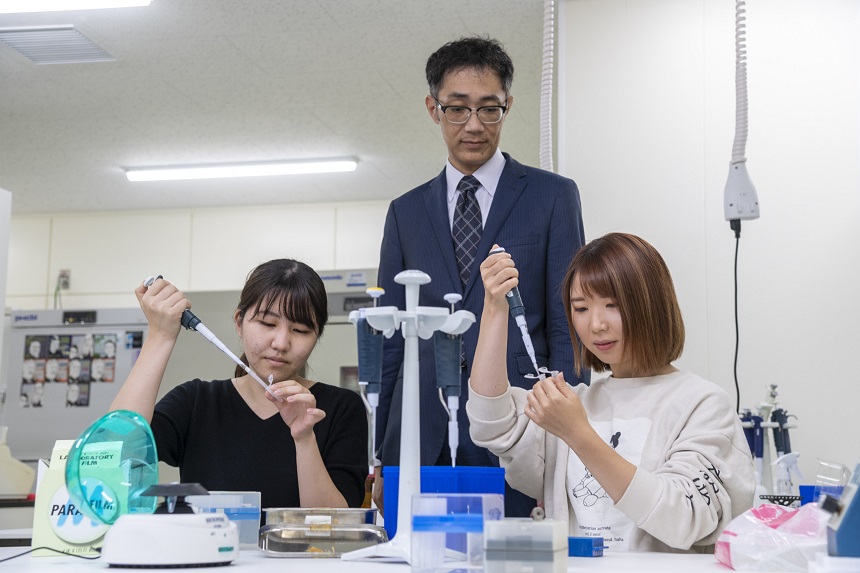On February 1, 2013, Hiroshima University established two new programs: the “Distinguished Professors” (DP) program and the “Distinguished Researchers” (DR) program. Individuals who are part of these programs are recognized as senior and junior faculty members respectively, who are engaged in extraordinarily distinguished research activities.
Interview of Distinguished Professor Masayuki Shimada

Applying the Results of Basic Research on the Mechanism of Fertility to Technologies that Are Useful in the Real World through University-Launched Ventures.
Application of Findings from Basic Research to Livestock Technology and Human Fertility Care
My field of expertise is reproductive biology. My research focuses on the reproductive system of mammals, using mice as experimental models, and I am trying to apply what I have learned from these studies to two outlets: practical use as livestock production technology and application in human fertility care.
The birth of a child is a natural phenomenon in nature, but in the case of livestock breeding, the process of breed improvement prioritizes meat quality and other factors over the stability of pregnancy and birth, which can cause reproductive problems. The problem arising when what is normal is no longer normal can only be solved if we can understand how what is normal occurs. Once we understand the normal mechanism and the difference between it and the abnormal one, we can develop prevention and care methods. I am researching the mechanism of fertility with the ultimate goal of eliminating unsuccessful pregnancies and births.
Although knowledge gained from basic research on mice cannot be directly applied to humans, in my laboratory, we have produced results that enable us to understand the human condition by creating infertile mouse models. Based on these results, we are also working on the development of treatments in collaboration with medical schools and private clinics.
With regard to livestock, we have established a university-launched venture, and are working in an integrated way from developing breeding technology in our laboratory to applying it in actual production settings. For example, the technology we developed to produce frozen boar semen is the only such technology in Japan that has been put to practical use, and we applied for a patent for it in 2007. In some cases, all pigs in a farm have to be destroyed due to swine fever or other reasons, but by preserving genetic resources with frozen semen, we can revive the brand-name breeds of pigs that farmers had been raising. In addition, our patented technology for artificial insemination is being used at many production sites in Japan, and much domestic porkt produced using Hiroshima University's technology are now on the market. One of the most exciting aspects of this research is that we can feel that our achievements are directly helping others.

Students at work in the Reproductive Biology Laboratory. A steady accumulation of basic research leads to technology that is useful in society.
The Discovery of a Protein expressed in only X-Sperm Leads to Develop Sexing Method
In addition, we are now focusing on research on a sexing method. You may have learned in science class that mammalian eggs have an X chromosome and sperm have either an X or Y chromosome, and that XX makes a female and XY makes a male. Through our basic research, we discovered a protein expression that is found only in X-sperm, and then developed a method in which X-sperm stop moving and Y-sperm continue swimming when stimulated by chemicals. This made it possible to use chemicals to separate the sexes. Although there have been methods to separate sperm using expensive machines that require meticulous and time-consuming work, our technology is revolutionary in that it is less expensive and can be done by anyone. In fact, using this method, the sperm simply separate on their own; all we have to do is collect the participating X-sperm. For humans, there are ethical issues, but in the case of livestock, the economic value of males and females differs greatly, so we are working on the practical application of artificial insemination in cattle and pigs.
The largest project currently underway is the Bill & Melinda Gates Foundation's attempt to increase the number of dairy cows in India in an effort to alleviate world poverty. This foundation emailed us soon after our paper was published in 2019, asking us to work with them, and they have donated a large amount of money for our research. India relies on dairy products for most of its animal protein, but the supply is not keeping pace with the population explosion. When they try to increase the number of female cows that become dairy cows, the same number of bulls are born, but since they cannot be killed because they are sacred under Hindu doctrine, they become stray and even cause sanitation problems by dropping feces and urine in the streets. Therefore, we are in the process of implementing a plan to increase the number of female cows by using our method for artificial insemination.

India's sanitation problem caused by stray bulls can be solved with sex selection technology
(photo taken during a visit to India as part of a bilateral exchange program with the National Institute of Animal Nutrition and Physiology, India)
Livestock Farming Is Also a Field Where Cutting-Edge Science Can Be Applied
Sex selection is important not only for cows but also for pigs. For example, there are brand-name breeds of pigs such as Sangenton, which are produced by crossing different breeds of female and male pigs. On the other hand, if male pigs are not castrated, their meat will become smelly, but castration is becoming a problem from the standpoint of animal welfare, and in some European countries it is banned. If this is the case, we need to increase the number of females only. With our technology, we can also guarantee animal welfare.
Death Valley is a metaphor used to describe the stage between early fundamental research-based innovation and industrial application, an arduous process which includes clinical trials. However, when it comes to livestock breeding technology, if a technology is deemed to be satisfactory, the results can be returned to society quickly. This allows giver-uppers like me to work hard on fundamental research. My current driving force is the desire to meet expectations for practical applications. I think I am a very lucky researcher to be able to experience in real time how the results of my research are useful in the real world.
Even if you have the means to solve a social problem, if you do not know about the problem, it will be a waste of your valuable resources. That is why I would like to further deepen our collaboration with industry to understand the issues and create a mechanism for the university to connect with society. I also hope that the next generation of people, such as the laboratory staff, will make use of the successful experience of this university-launched venture and achieve new results.

 Home
Home